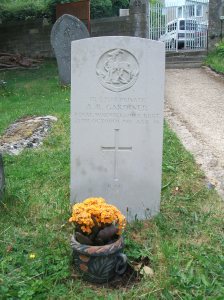A still, leafy, place on the edge of the hill: a peaceful place to lie – whether living or dead. Startlingly, the churchyard at St John’s, France Lynch, contains five Great War graves. Look a little closer, and – even more disconcerting – you will notice that three of the five young men died within days of each other, and were buried in their familiar village cemetery in the space of just over a week. Eight days in November 1918.
Alfred Rupert Gardiner, known as Rupert, died three months after his 18th birthday on 25th October, of pneumonia which had developed from the ‘flu. The Stroud Journal noted that ‘he joined the Army on reaching the qualifying age some months ago, and was a promising young man’. He had grown up in France Lynch. He was taken ill while training in Norfolk, for a war that would be over in less than a month, in which he would never have faced fire.
The same edition of the paper related how Mr Elisha (actually Elijah) Damsell had ‘left Chalford on Wednesday evening at the request of the authorities to visit his son, who is in the Army and is dangerously ill’. Frank Damsell died aged 20 on 29th October, again of pneumonia caused by influenza. His record card, badly charred, survived the bombing of the Army offices in the Second World War, and contains graphic details of the progress of poor Frank’s illness. One of five children, he lived in The Glen, France Lynch, and had worked at Chalford Stick Company before enlisting in the Devons just before his 18th birthday. He was categorised as C1, and therefore not fit for frontline service. Instead, he was occupied in home duties with the Labour Corps when he fell ill, and was taken to Balmer Lawn hospital in the New Forest.
Frank was buried on Saturday, November 2nd, beyond the East window of the church . On Sunday 3rd, Rupert was laid to rest beside the path down to the church, his ‘body not arriving in Chalford in time to be associated with the interment of Pte Frank Damsell’. Against both their entries in the burial register, the Revd Wade-Evans has written ‘died of influenza’.
Wilfred Hale (who appears in Army records as ‘William’), unlike Frank and Rupert did see active service and did die as a result of injury. Born in 1892, the 1911 census records him living with his family in Prospect Terrace and working in a stick factory. According to the Journal, some time after that, Wilfred moved away:
The gallant soldier was at work in Wales when war was declared, and he joined the Royal Welsh Fusiliers a week after the commencement of hostilities…He served with the Balkan Expeditionary Force for over two years. Then he was given leave, and at the expiration of that he was sent to France, where, after seeing much fighting, he was wounded in both thighs, and sent to England for treatment. He recovered, and was again despatched to France in October, 1917. In September, this year, he was severely wounded in the head, and brought to England, his death ensuing…Deceased’s only brother was unable to attend [the funeral], he being on active service in Egypt.
Wilfred died on 30th October, aged 25. He was buried on Saturday, November 8th.
Under the entry in the burial register for Wilfred, which is (handily) at the bottom of the page, Wade-Evans wrote ‘ARMISTICE DECLARED BETWEEN ENGLAND AND GERMANY NOVEMBER 11TH 1918 LAUS DEO [praise God]’.



